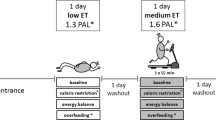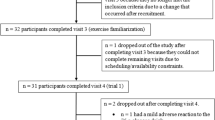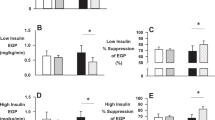Abstract
Objective:
The aim of this study was to examine the metabolic responses during 1 h of brisk walking, 3 h after ingesting high glycemic index (HGI) and moderate glycemic index (MGI) breakfasts.
Design and subjects:
Six females completed three treadmill walking trials (∼50% V̇O2 max), separated by at least 1 month. Three hours before walking, they ingested either water or a HGI or MGI breakfast. The MGI breakfast consisted of a mixture of an HGI breakfast cereal and low GI carbohydrate (CHO) foods. The GI values of the HGI and MGI meals were 77 and 51, respectively.
Setting:
The study took place in the School of Sport and Exercise Sciences at Loughborough University, Loughborough, UK.
Results:
In the HGI and MGI trials, plasma glucose and serum insulin concentrations peaked 15 min into the postprandial period. At the onset of exercise, plasma insulin concentrations were twofold higher in the HGI (31.5±7.7 μl U l−1) than in the MGI trial (15.2±1.9 μl U l−1) (P<0.05). However, there were no differences in substrate utilization between the two CHO trials.
Conclusion:
These results suggest that although the addition of LGI CHO foods to an HGI breakfast cereal reduces the overall GI of the meal, the metabolic response to exercise is similar to that following a breakfast comprised entirely of HGI foods.
This is a preview of subscription content, access via your institution
Access options
Subscribe to this journal
Receive 12 print issues and online access
$259.00 per year
only $21.58 per issue
Buy this article
- Purchase on Springer Link
- Instant access to full article PDF
Prices may be subject to local taxes which are calculated during checkout





Similar content being viewed by others
References
Borg GA (1982). Psychophysical bases of perceived exertion. Med Sci Sports Exerc 14, 377–381.
Costill DL, Coyle E, Dalsky G, Evans W, Fink W, Hoopes D (1977). Effects of elevated plasma FFA and insulin on muscle glycogen usage during exercise. J Appl Physiol 43, 695–699.
Coulston AM, Hollenbeck CB, Liu GC, Williams RA, Starich GH, Mazzaferri EL et al. (1984). Effect of source of dietary carbohydrate on plasma glucose, insulin, and gastric inhibitory polypeptide responses to test meals in subjects with noninsulin-dependent diabetes mellitus. Am J Clin Nutr 40, 965–970.
DeMarco HM, Sucher KP, Cisar CJ, Butterfield GE (1999). Pre-exercise carbohydrate meals: application of glycemic index. Med Sci Sports Exerc 31, 164–170.
Diaz EO, Galgani JE, Aguirre CA, Atwater IJ, Burrows R (2005). Effect of glycemic index on whole-body substrate oxidation in obese women. Int J Obes (London) 29, 108–114.
Febbraio MA, Keenan J, Angus DJ, Campbell SE, Garnham AP (2000). Preexercise carbohydrate ingestion, glucose kinetics, and muscle glycogen use: effect of the glycemic index. J Appl Physiol 89, 1845–1851.
Febbraio MA, Stewart KL (1996). CHO feeding before prolonged exercise: effect of glycemic index on muscle glycogenolysis and exercise performance. J Appl Physiol 81, 1115–1120.
Foster-Powell K, Holt SH, Brand-Miller JC (2002). International table of glycemic index and glycemic load values: 2002. Am J Clin Nutr 76, 5–56.
Frayn KN (1983). Calculation of substrate oxidation rates in vivo from gaseous exchange. J Appl Physiol 55, 628–634.
Gold AE, MacLeod KM, Frier BM, Deary IJ (1995). Changes in mood during acute hypoglycemia in healthy participants. J Personality a Social Psychol 68, 498–504.
Henry RR, Crapo PA, Thorburn AW (1991). Current issues in fructose metabolism. Annu Rev Nutr 11, 21–39.
Hollenbeck CB, Coulston AM, Reaven GM (1988). Comparison of plasma glucose and insulin responses to mixed meals of high-, intermediate-, and low-glycemic potential. Diabetes Care 11, 323–329.
Jenkins DJ, Wolever TM, Taylor RH, Barker H, Fielden H, Baldwin JM et al. (1981). Glycemic index of foods: a physiological basis for carbohydrate exchange. Am J Clin Nutr 34, 362–366.
Koivisto VA, Karonen SL, Nikkila EA (1981). Carbohydrate ingestion before exercise: comparison of glucose, fructose, and sweet placebo. J Appl Physiol 51, 783–787.
Ludwig DS, Majzoub JA, Al-Zahrani A, Dallal GE, Blanco I, Roberts SB (1999). High glycemic index foods, overeating, and obesity. Pediatrics 103, E26.
Messer SC, Morris RL, Gross AM (1990). Hypoglycemia and psychopathology: a short term memory, concentration, mood and blood glucose. Clin Psychol Review 10, 631.
Moore MC, Cherrington AD, Mann SL, Davis SN (2000). Acute fructose administration decreases the glycemic response to an oral glucose tolerance test in normal adults. J Clin Endocrinol Metab 85, 4515–4519.
Paul GL, Rokusek JT, Dykstra GL, Boileau RA, Layman DK (1996). Preexercise meal composition alters plasma large neutral amino acid responses during exercise and recovery. Am J Clin Nutr 64, 778–786.
Sparks MJ, Selig SS, Febbraio MA (1998). Pre-exercise carbohydrate ingestion: effect of the glycemic index on endurance exercise performance. Med Sci Sports Exerc 30, 844–849.
Stevenson E, Williams C, Mash L, Phillips B, Nute M (2006). Influence of high-carbohydrate mixed meals with different glycemic indexes on substrate utilization during subsequent exercise in women. Am J Clin Nutr 84, 354–360.
Stevenson E, Williams C, Nute M (2005). The influence of the glycaemic index of breakfast and lunch on substrate utilisation during the postprandial periods and subsequent exercise. Br J Nutr 93, 885–893.
Thomas DE, Brotherhood JR, Brand JC (1991). Carbohydrate feeding before exercise: effect of glycemic index. Int J Sports Med 12, 180–186.
Wee SL, Williams C, Gray S, Horabin J (1999). Influence of high and low glycemic index meals on endurance running capacity. Med Sci Sports Exerc 31, 393–399.
Wee SL, Williams C, Tsintzas K, Boobis L (2005). Ingestion of a high-glycemic index meal increases muscle glycogen storage at rest but augments its utilization during subsequent exercise. J Appl Physiol 99, 707–714.
Williams C, Nute MG, Broadbank L, Vinall S (1990). Influence of fluid intake on endurance running performance. A comparison between water, glucose and fructose solutions. Eur J Appl Physiol Occup Physiol 60, 112–119.
Wolever TM, Jenkins DJ (1986). The use of the glycemic index in predicting the blood glucose response to mixed meals. Am J Clin Nutr 43, 167–172.
Wu CL, Nicholas C, Williams C, Took A, Hardy L (2003). The influence of high-carbohydrate meals with different glycaemic indices on substrate utilisation during subsequent exercise. Br J Nutr 90, 1049–1056.
Acknowledgements
The authors would like to thank Michelle Allmark and Claire Bennett for their help in the data collection process.
Author information
Authors and Affiliations
Corresponding author
Additional information
Contributors: SHB was involved in all parts of the study from conception to preparation of the final manuscript. CW was involved in the project design, discussion and interpretation of results and manuscript preparation. ES was involved in data analysis, discussion and interpretation of results and manuscript preparation. MN was involved in the experimental aspects of the study and sample collection, analysis and interpretation.
Rights and permissions
About this article
Cite this article
Backhouse, S., Williams, C., Stevenson, E. et al. Effects of the glycemic index of breakfast on metabolic responses to brisk walking in females. Eur J Clin Nutr 61, 590–596 (2007). https://doi.org/10.1038/sj.ejcn.1602566
Received:
Revised:
Accepted:
Published:
Issue Date:
DOI: https://doi.org/10.1038/sj.ejcn.1602566
Keywords
This article is cited by
-
Acute and chronic effects of multivitamin/mineral supplementation on objective and subjective energy measures
Nutrition & Metabolism (2020)
-
Effect of breakfast glycemic index on metabolic responses during rest and exercise in overweight and non-overweight adolescent girls
European Journal of Clinical Nutrition (2012)
-
Substrate utilization during brisk walking is affected by glycemic index and fructose content of a pre-exercise meal
European Journal of Applied Physiology (2012)



